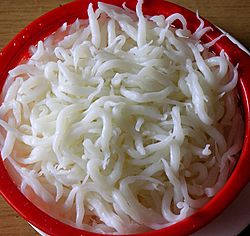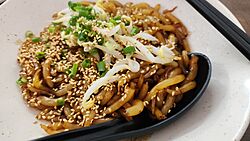Silver needle noodles facts for kids
 |
|
| Alternative names | Rat noodle |
|---|---|
| Type | Chinese noodles |
| Place of origin | China, Meizhou |
| Main ingredients | Rice flour |
| Silver needle noodles | |||||||||||
|---|---|---|---|---|---|---|---|---|---|---|---|
| Chinese name | |||||||||||
| Traditional Chinese | 銀針粉 | ||||||||||
| Simplified Chinese | 银针粉 | ||||||||||
| Literal meaning | silver needle noodle | ||||||||||
|
|||||||||||
| Alternative Chinese name | |||||||||||
| Chinese | 老鼠粉 | ||||||||||
| Literal meaning | rat noodle | ||||||||||
|
|||||||||||
| Second alternative Chinese name | |||||||||||
| Traditional Chinese | 米篩目 | ||||||||||
| Simplified Chinese | 米筛目 | ||||||||||
| Literal meaning | rice sieve eyes | ||||||||||
|
|||||||||||
| Vietnamese name | |||||||||||
| Vietnamese alphabet | bánh lọt mặn | ||||||||||
| Thai name | |||||||||||
| Thai | เกี้ยมอี๋ | ||||||||||
| RTGS | kiam-i | ||||||||||
| Khmer name | |||||||||||
| Khmer | លត | ||||||||||
Silver needle noodles are a special type of Chinese noodles loved in many parts of Asia! These short, white, and slightly see-through noodles are about 5 centimeters (2 inches) long and 5 millimeters (0.2 inches) wide. You can find them in bustling markets and restaurants across places like Hong Kong, Taiwan, Cambodia, Indonesia, Malaysia, Thailand, Vietnam, and Singapore. They have many fun names, like "rat noodle" or "runny nose vermicelli," which describe their unique shape!
Contents
Discovering Silver Needle Noodles
What's in a Name?
These interesting noodles have different names depending on where you are. In Hong Kong and Taiwan, they are often called silver needle noodles. This is because they look like tiny, shiny needles. But in Malaysia and Singapore, people sometimes call them rat noodles or "runny nose vermicelli." Don't worry, it's just because their tapered shape reminds some people of a rat's tail or a drop of liquid! Another name, bee tai bak, comes from how they are made by pushing the dough through a sieve.
How These Noodles Are Made
Making silver needle noodles is a special craft! They are usually made from rice flour, which comes from ground rice, mixed with water. Sometimes, a little cornstarch is added. This helps the noodles stay strong and not break easily when they are cooked.
Skilled noodle makers carefully shape and roll the dough by hand. They create the noodles' famous needle-like shape. After shaping, the noodles are gently steamed until they are perfectly cooked. Since it takes a lot of practice and effort to make them, you'll usually find these noodles fresh from special noodle shops or markets, rather than homemade.
Enjoying Silver Needle Noodles
Silver needle noodles are super versatile and can be enjoyed in many delicious ways!
Cooking Methods
You might find them:
- Stir-fried with tasty sauces and vegetables.
- Served in a warm soup broth.
- Mixed with a variety of sauces for a simple, flavorful dish.
- Cooked in a special clay-pot. This method keeps the noodles warm and delicious for a longer time!
These noodles are a popular meal any time of day – for breakfast, lunch, or dinner. Many street food vendors and restaurants in Southeast Asia serve them. One famous dish is "Clay-Pot Lao Shu Fen," which is a hearty and comforting meal.
See also
 In Spanish: Fideos aguja de plata para niños
In Spanish: Fideos aguja de plata para niños


